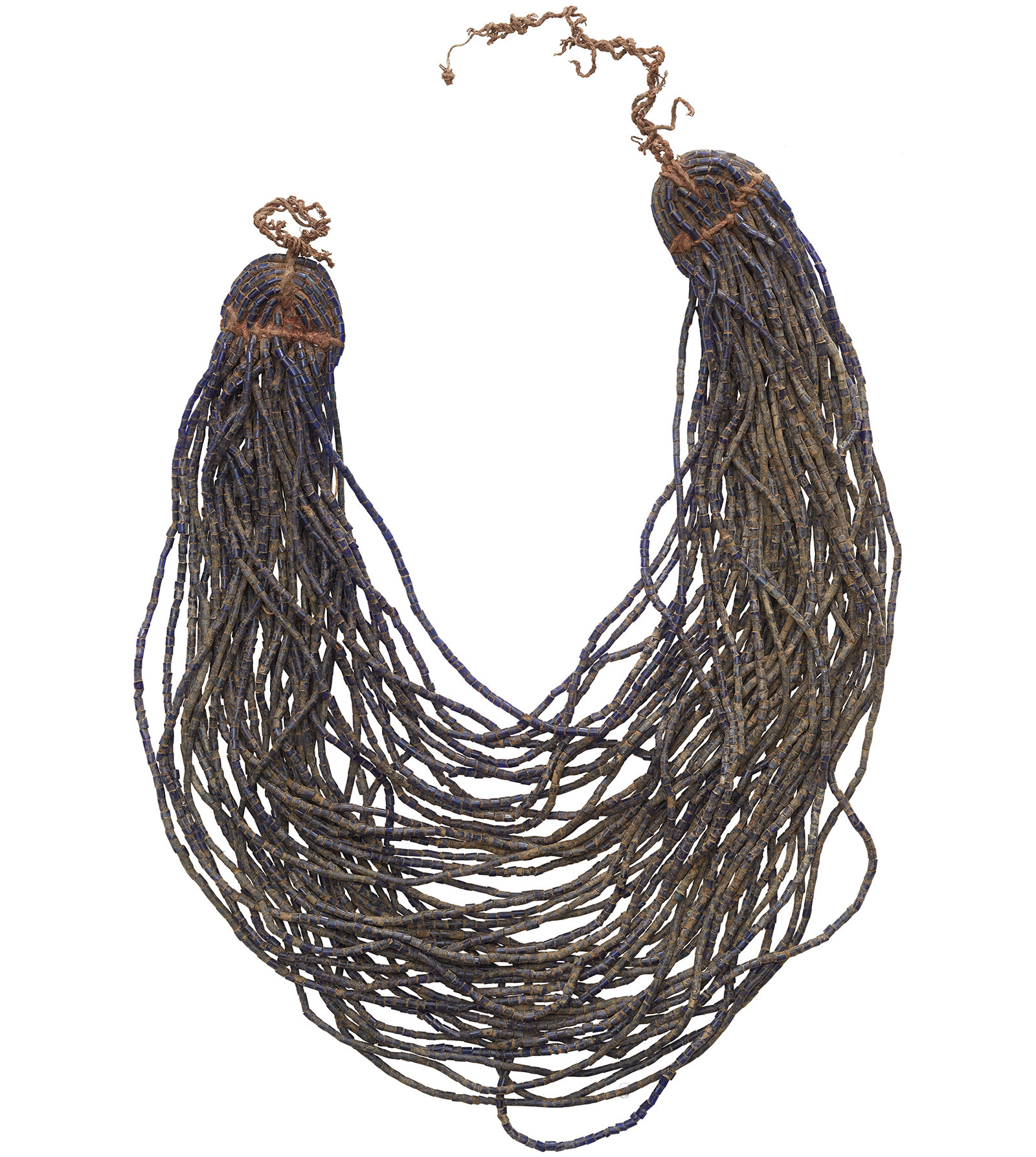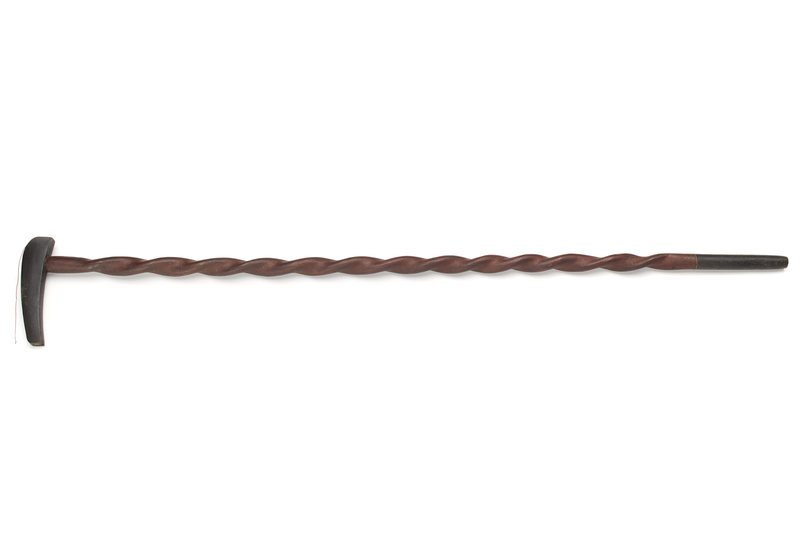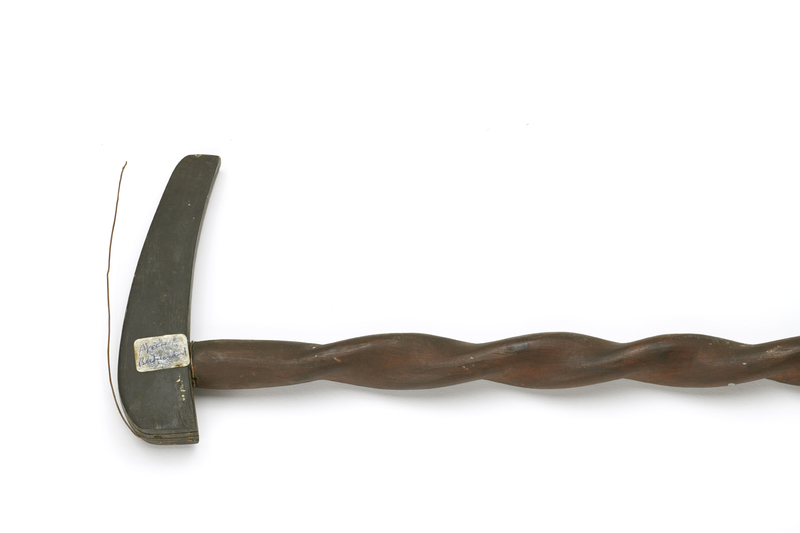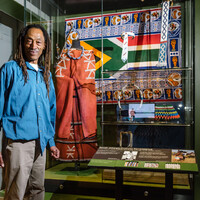Walking Stick; Thobane
Item
Title
Walking Stick; Thobane
Creator
Unrecorded
Description
Physical Description: Wooden walking stick made of a dark red wood, with a stem carved into a twisted design and a cross handle of horn inlaid with copper wire. The horn inlay may be made from rhinocerous horn.
Contextual Description: 02:48:37 It’s a walking stick and he says it’s the kind that he doesn’t like because it will actually speed aging after using it for a month or so you start losing shape like sagging that way [stoops] and the more you use it you are becoming really really old and developing a slight stoop in your back.He doesn’t want to use a walking stick at all cos that will make him lean forward. He doesn’t like the walking sticks!
There are lots of Morukoru trees, and he says that was what was used for making walking sticks mostly. That’s what we suspect the bangles were made of because it has like this very hard centre part which also has an interesting smell. That is why people like to make poles to support their roof structure of a Rondavel they would use Morukoru. Termites would be reluctant to attach Morukoru so if you make your poles out of that they will last a lot longer. It has some kind of a smell which will discourage pests. Transcription by KL of MAC_BB_20190817_RPM3 SL Interview with Tshupo Ntono, Village Elder, Language: Setswana with English translations by SL, 2019
There are lots of Morukoru trees, and he says that was what was used for making walking sticks mostly. That’s what we suspect the bangles were made of because it has like this very hard centre part which also has an interesting smell. That is why people like to make poles to support their roof structure of a Rondavel they would use Morukoru. Termites would be reluctant to attach Morukoru so if you make your poles out of that they will last a lot longer. It has some kind of a smell which will discourage pests. Transcription by KL of MAC_BB_20190817_RPM3 SL Interview with Tshupo Ntono, Village Elder, Language: Setswana with English translations by SL, 2019
Publisher
Making African Connections
Date
Pre 1899
Type
PhysicalObject
Format
Whole: 940 mm x 140 mm x 30 mm
Wood; Horn; Copper; Possible rhinoceros horn
Identifier
R4007/114
Source
Collected by Reverend William Charles Willoughby, a Christian missionary, in what was then the Bechuanaland Protectorate (1885-1966). It is now the Republic of Botswana, having gained independence from Britain in 1966.
From 1889-92 Willoughby was pastor at Union Street Church, Brighton (now The Font pub). From 1893 to 1898 he worked for the London Missionary Society in Bechuanaland. He assembled this collection of objects during this period. This was a period of social and technological changes and these objects represent traditional lifestyles and skills, rather than the contemporary lives of the people Willoughby met.
Willoughby's collection was loaned to Brighton Museum in 1899 when he returned to the UK. The loan was converted into a donation in 1936, and accessioned as acquisition R4007.
Some objects were re-numbered with the WA (World Art) numbering system in the 2000s. These numbers have been reverted to the original R4007/... numbers where possible for consistency in 2019.
From 1889-92 Willoughby was pastor at Union Street Church, Brighton (now The Font pub). From 1893 to 1898 he worked for the London Missionary Society in Bechuanaland. He assembled this collection of objects during this period. This was a period of social and technological changes and these objects represent traditional lifestyles and skills, rather than the contemporary lives of the people Willoughby met.
Willoughby's collection was loaned to Brighton Museum in 1899 when he returned to the UK. The loan was converted into a donation in 1936, and accessioned as acquisition R4007.
Some objects were re-numbered with the WA (World Art) numbering system in the 2000s. These numbers have been reverted to the original R4007/... numbers where possible for consistency in 2019.
William Charles Willoughby
Botswana, Southern Africa, Africa
1893-1898
Space/Place
Botswana, Southern Africa, Africa
Cultural Group: Tswana
Rights
Creative Commons Attribution-ShareAlike 4.0 International







